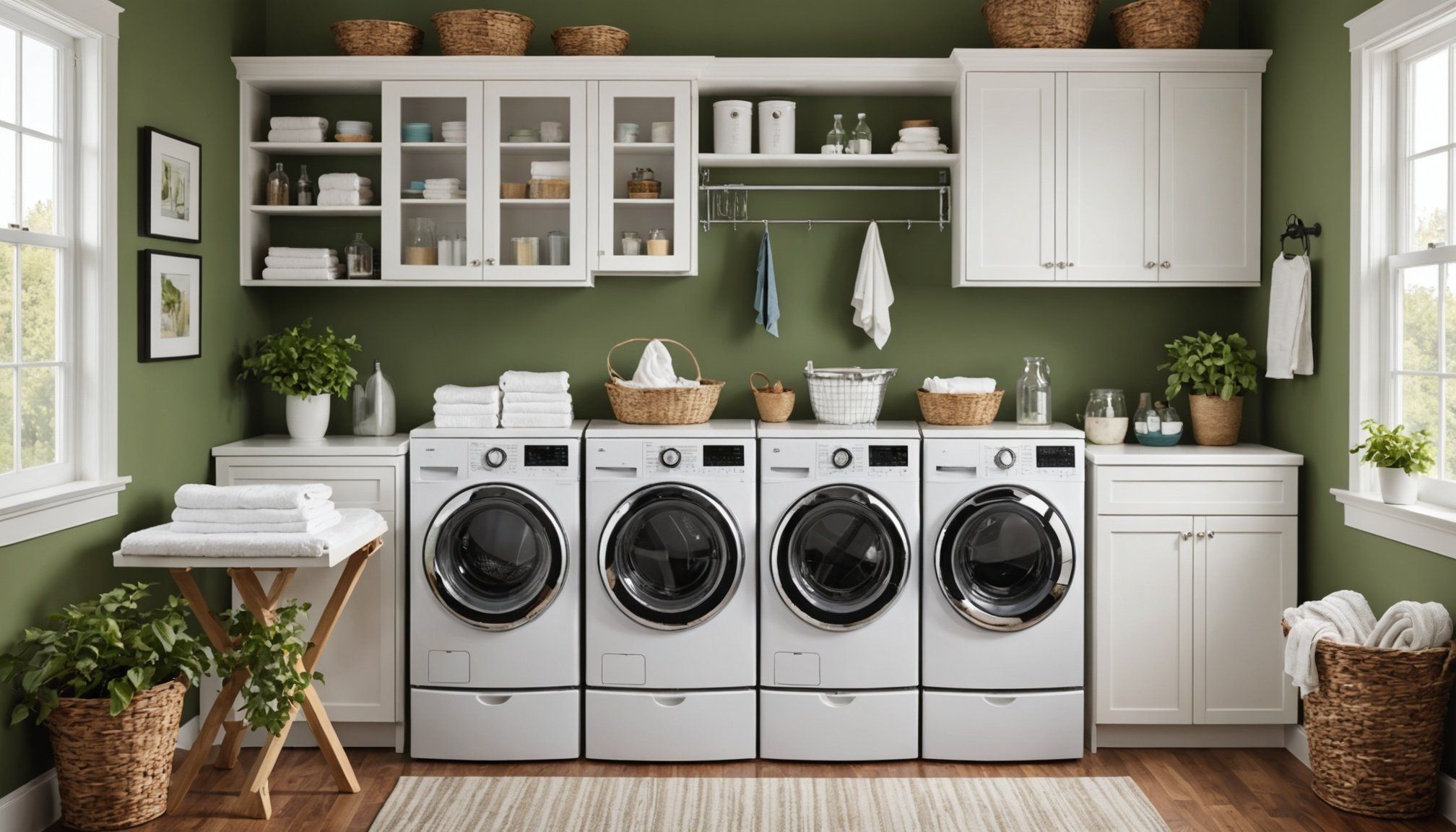Transform Your Laundry Room with Eco-Friendly Solutions: Innovative Tips for a Sustainable Space Featuring Cutting-Edge Appliances
In the quest for a more sustainable lifestyle, one often overlooked but crucial area is the laundry room. With the increasing awareness of environmental issues, it’s time to transform your laundry space into an eco-friendly haven. Here’s how you can do it, equipped with the latest technology and innovative tips.
Embracing Water Conservation: The Heart of Eco-Friendly Laundry
Water conservation is at the forefront of sustainable laundry practices. The statistics are alarming: a quarter of the global population faces extreme water stress every year, and by 2050, this situation is expected to worsen dramatically, with an additional 1 billion people facing extreme water stress[1].
Also read : Elevate your home gym: crafting an energizing color palette for enhanced focus and motivation
Zero Water Solutions
Companies like Girbau are leading the charge with their Zero Water platform, designed to dramatically reduce water consumption. Here are some key strategies:
- Tailored Recovery Systems: These systems can reuse up to 85% of water, significantly reducing consumption and waste. For instance, single-machine setups can achieve up to 35% water reuse, while centralized systems can reach up to 85% in ongoing pilots[1].
- Cost Savings: Reusing water not only protects the environment but also cuts operational costs, making it a win-win for both the planet and your wallet.
- SDG Alignment: These solutions contribute to the United Nations Sustainable Development Goals (SDGs) by promoting responsible water use and protecting the environment from pollution and waste.
Practical Tips for Home Use
For those at home, here are some practical tips to conserve water:
Additional reading : Revamp your kitchen: creative strategies for streamlined organization and cutting down on food waste
- Wash Full Loads: Running a washing machine for partial loads wastes water and energy. Wait until you have a full load to maximize efficiency[3][4].
- Use Water-Efficient Machines: Invest in washing machines with adjustable load sizes and water-saving features. These machines use significantly less water compared to traditional models[4].
Optimizing Energy Use: Smart Appliances for a Greener Future
Energy efficiency is another critical aspect of eco-friendly laundry practices. Here’s how you can optimize your energy use:
Zero Energy Solutions
Girbau’s Zero Energy systems are designed to reduce energy consumption and lower the carbon footprint of laundry operations.
- Energy Recovery: Advanced systems reuse heat and energy at multiple stages of the laundry process. For example, machines like the Genius washers and ED dryers are engineered for maximum output with minimal energy use[1].
- Efficient Equipment: Look for appliances with high energy efficiency ratings. These machines not only reduce your energy consumption but also translate to significant cost savings.
Home Energy-Saving Tips
Here are some tips to make your laundry routine more energy-efficient at home:
- Wash at Lower Temperatures: Heating water accounts for most of the energy used in laundry. Washing at lower temperatures, such as cold or 30°C, can save a substantial amount of energy without compromising cleaning performance[2][3].
- Air-Dry Your Clothes: Clothes dryers consume significant energy and can damage fabrics over time. Line drying is not only energy-efficient but also better for your clothes[2][3].
Protecting Water Quality: The Battle Against Microfibers
Microfiber pollution is a growing environmental concern, and the laundry industry plays a significant role in addressing this issue.
Zero Microfibers Solutions
Girbau’s advanced filtration systems are designed to remove microfibers and microplastics from wastewater.
- Effective Filtration: These systems can remove up to 90% of microfibers and microplastics, filtering particles as small as 50 microns at a flow rate of 7 m³/h[1].
- Environmental Leadership: By preventing harmful particles from entering waterways, these systems demonstrate environmental leadership and compliance with upcoming microplastics regulations.
Home Tips for Reducing Microfiber Pollution
Here’s what you can do at home to reduce microfiber pollution:
- Use Eco-Friendly Detergents: Opt for detergents that are free from harsh chemicals and synthetic fragrances, which can contribute to microfiber pollution[3].
- Wash Clothes Gently: Avoid overwashing your clothes, as this can release more microfibers into the water system.
Reducing Waste: The Move to Zero Packaging
Packaging waste is another significant issue in the laundry industry. Here’s how you can reduce waste in your laundry room:
Zero Packaging Solutions
Girbau’s Zero Packaging solutions aim to eliminate plastic packaging by using recycled and recyclable materials.
- Eco-Friendly Packaging: By using recycled and recyclable paper, these solutions cut CO₂ emissions by up to 95% and reduce operational expenses through lower electricity use and disposal fees[1].
- Seamless Integration: These solutions are easily adaptable to existing laundry operations, making the transition to sustainable packaging smooth and efficient.
Home Tips for Reducing Packaging Waste
Here are some tips to reduce packaging waste in your home laundry routine:
- Refillable Laundry Detergent: Use refillable laundry detergent systems that eliminate single-use plastic bottles. These systems are biodegradable, gentle on your skin, and tough on stains[2].
- Choose Products with Minimal Packaging: Opt for products that come in minimal or biodegradable packaging to reduce waste.
Smart and Efficient Appliances: The Future of Laundry
Investing in smart and efficient appliances is a crucial step in transforming your laundry room into an eco-friendly space.
Cutting-Edge Appliances
Here are some features to look for in cutting-edge, eco-friendly appliances:
- Energy Star Ratings: Look for appliances with high Energy Star ratings, which indicate that the machines use less water and electricity, reducing your utility bills and environmental impact[3][4].
- Advanced Technology: Machines equipped with advanced technology, such as Girbau’s Genius washers and ED dryers, are designed for maximum efficiency and minimal energy use[1].
Space-Saving and Efficient Machines
For those with limited space, here are some tips for choosing space-saving and efficient machines:
- Compact Designs: Opt for compact washer and dryer designs that are space-efficient without compromising on performance.
- Multi-Functional Machines: Consider multi-functional machines that combine washing and drying functions, reducing the need for separate appliances and saving space.
Creating a Sustainable Laundry Routine: Tips and Tricks
Transitioning to a sustainable laundry routine doesn’t have to be daunting. Here are some tips and tricks to help you make the shift:
Eco-Friendly Laundry Tips
Here are some detailed tips to make your laundry routine more eco-friendly:
- Wash at Lower Temperatures: As mentioned earlier, washing at lower temperatures saves energy and extends the life of your clothes[2][3].
- Use Eco-Friendly Detergents: Opt for detergents that are plant-based, biodegradable, and free of harsh chemicals like sulfates and artificial dyes[3].
- Air-Dry Your Clothes: Line drying is energy-efficient and better for your clothes. If you must use a dryer, use eco-friendly dryer balls to speed up the drying process and remove static[2][3].
- Shorter Cycles with Effective Detergents: Use concentrated detergents that work effectively in short cycles, reducing water and energy usage without compromising cleanliness[2].
Encouraging Eco-Friendly Practices in Your Community
Encouraging eco-friendly laundry practices among residents or community members can lead to a substantial reduction in energy and water consumption.
Promoting Water Conservation Techniques
Here are some strategies to promote water conservation in laundry practices:
- Educate on Full Loads: Raise awareness about the importance of washing full loads rather than multiple smaller loads. This can significantly cut down on water usage[4].
- Promote Water-Saving Machines: Encourage the use of washing machines with adjustable load sizes and water-saving features[4].
Encouraging the Use of Eco-Friendly Detergents
Here’s how you can encourage the use of eco-friendly detergents:
- Provide Education and Resources: Inform residents about the benefits of eco-friendly detergents, their effectiveness, and their health benefits. Organize informational sessions or distribute educational materials to demystify these products[4].
- Implement Incentives: Establish a reward system that recognizes residents who opt for eco-friendly detergents, wash their clothes in cold water, and use energy-efficient machines and dryers[4].
Table: Comparing Eco-Friendly Laundry Solutions
Here’s a comparative table highlighting some of the key eco-friendly laundry solutions available:
| Solution | Description | Benefits | Examples |
|---|---|---|---|
| Zero Water | Tailored recovery systems to reuse water | Reduces water consumption and waste, cost savings | Girbau’s Zero Water platform[1] |
| Zero Microfibers | Advanced filtration systems to remove microfibers | Protects water quality, environmental leadership | Girbau’s filtration systems[1] |
| Zero Energy | Energy recovery systems and efficient equipment | Reduces energy consumption, lower carbon footprint | Girbau’s Genius washers and ED dryers[1] |
| Zero Packaging | Use of recycled and recyclable materials | Reduces packaging waste, cuts CO₂ emissions | Girbau’s Zero Packaging solutions[1] |
| Eco-Friendly Detergents | Plant-based, biodegradable detergents | Reduces pollution, better for skin and environment | nil’s refillable laundry detergent[2], ESNTL LVG’s non-toxic detergents[3] |
| Energy-Efficient Appliances | Machines with high Energy Star ratings | Reduces energy consumption, lower utility bills | Energy Star rated washing machines and dryers[3][4] |
Quotes and Insights from Experts
- “Sustainability is about more than technology; it’s about positively impacting people and the planet,” says Girbau, highlighting the holistic approach to sustainability that includes improving workers’ lives, reducing operational costs, and protecting the planet[1].
- “Transitioning to a green laundry routine doesn’t have to be daunting. By making small, manageable changes—like using eco-friendly products, conserving energy and water, and incorporating natural cleaning solutions—you can significantly reduce your environmental impact while creating a healthier home,” advises ESNTL LVG[3].
Simplifying Your Green Laundry Transition
Transitioning to a green laundry routine can start with small, manageable changes. Here are some steps to simplify the process:
Start with Small Changes
- Use Reusable Glass Bottles: Switch to reusable glass bottles for mixing and storing homemade or refillable cleaning products. This reduces waste and adds a touch of style to your laundry space[3].
- Opt for Non-Toxic Detergents: Choose detergents labeled as plant-based, biodegradable, or free of harsh chemicals. These products break down naturally, reducing the risk of pollution[3].
Incorporate Natural Cleaning Solutions
- Make Your Own Fabric Softeners: Mix your own fabric softeners using simple ingredients like vinegar and essential oils. This minimizes your environmental impact and helps you avoid harsh chemicals[3].
- Use Stain Removers Wisely: Use stain removing soap for spot cleaning and reusable wool dryer balls to soften fabrics naturally, reducing the need for chemical-laden fabric softeners[2].
By adopting these eco-friendly solutions and tips, you can transform your laundry room into a sustainable space that not only benefits the environment but also enhances your home and well-being. Remember, every small change counts, and together, we can make a significant difference in our journey towards a greener future.



